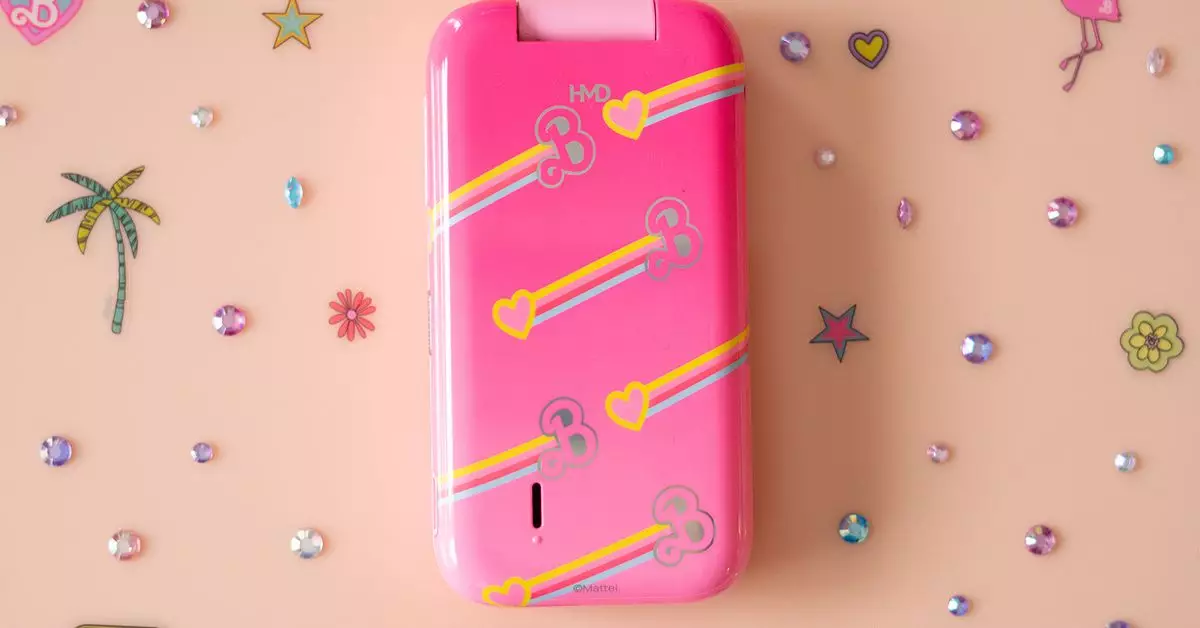The Barbie Phone emerges as a novel blend of nostalgia and playful aesthetics that pay homage to the beloved doll. Authored by Allison Johnson, a seasoned technology reviewer, the article immerses readers in the joys and disappointments of this unusual device. While the Barbie Phone envelops itself in a vibrant, ultra-feminine design, as one would expect from the Barbie universe, it simultaneously grapples with challenges that hinder its practical usability in our modern, technology-driven society.
The device’s marketing closely aligns with an ethos aimed at disconnecting from the relentless demands of smartphones. Yet, the enchanting exterior is eclipsed by an operating system designed for minimal connectivity—a feature phone that does little more than facilitate basic communication. The initial charm of the Barbie Phone, characterized by its delightful packaging, tactile elements like interchangeable back plates and glamorous stickers, is dazzling but superficial. The phone’s enchantment fades as real-world functionality becomes evident, revealing an incongruous juxtaposition between its whimsical design and its cumbersome usability.
With its operating system, KaiOS, the Barbie Phone is an instrument meant for those who seek a more straightforward mobile experience. However, the experience is less about technological liberation and more about stepping back in time—a decision that inherently carries its own set of frustrations. For tech-savvy users accustomed to seamless lines of communication, the idea of reverting to T9 typing in lieu of a more intuitive touchscreen interface can prove to be a daunting task.
The nostalgic allure of this phone, presented through cheeky features such as the phone’s voice greeting “Hi Barbie!” when powered on, quickly clashes with the practical difficulties of daily use. Johnson’s review highlights experiences that would resonate with anyone attempting to navigate modern authentication systems, such as entering complex passwords on a limited keypad. Challenges like syncing a calendar only to find misaligned appointments serve to further chalk up the device as more of a curiosity than a functional tool for the average consumer.
Amidst its playful aesthetic, the phone appears to be rooted in a deeper message from its manufacturer: a callback to valuing interpersonal connections over digital ones. The so-called “Barbie Tips” embedded within the device underscore a philosophy designed to inspire users to establish tech-free zones, like “Dream Houses.” However, this product ultimately raises questions about whether we should prioritize such ideals over a user experience that fails to meet contemporary demands.
Despite the initial thrill of unboxing and the straightforward excitement of a pink charger and stylized interface, the reality of using the Barbie Phone not only dampens its allure but prompts a re-evaluation of its purpose. Is it simply a collector’s item to appreciate in isolation, resembling the doll it is modeled after, yet impractical for the hustle and bustle of daily life?
The allure of the Barbie Phone beckons users to try it as a form of digital detox, an alternative to an ultra-connected lifestyle. However, Johnson’s reflections reveal that the experience transitions from lighthearted whimsy to frustration, reverting the user back to familiar modern annoyances. The thrill of escapism through this pink device often morphs into a new brand of inconvenience. Rather than replacing the trials of traditional smartphones with joyful simplicity, it appears to merely offer a different kind of stress.
For individuals who might embrace the T9 typing nostalgia, the Barbie Phone remains a cute memento, conceivably enjoyable for limited interaction. Still, the overwhelming consensus leans toward viewing it not as an essential tool for communication but rather as a novelty item meant to be appreciated for its design—one that can be enjoyed briefly but ultimately gathers dust in a drawer.
The Barbie Phone embodies much of what we cherish about the past—a playful nod towards simpler times—but struggles to adapt to the functionality required in our modern lives. While it serves as an eye-catching piece of memorabilia, providing a momentary escape into a whimsical world, it falters as a useful communication device. The realization that the attempt at significant tech-rediscovery within the confines of the Barbie Phone offers a dissonance between expectation and reality is precisely the crux of Johnson’s critique. Ultimately, this phone is best suited for enthusiasts who value its artfulness over its practicality, serving more as a fleeting connection to childhood memories than as a reliable means of communication.


Leave a Reply